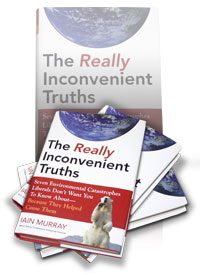
The Really Inconvenient Truths: Seven Environmental Catastrophes Liberals Don’t Want You to Know About — Because They Helped Cause Them, by Iain Murray, Regnery 2008, 354 pages, hardcover.
A man named Benjamin Cone from North Carolina bought land with no trees and allowed the forest to grow back on it. Once the forest returned, a protected woodpecker moved in, prompting the government, under rules of the Endangered Species Act, to prohibit any meaningful use of a large portion of his land – he was denied the right to any logging, driving the value of his property down from $1.7 million to about $260,000. The new feathered resident and the accompanying plunge in his land’s value caused a reasonable response: the owner decided to clear-cut the rest of the forest to avoid losing it to the woodpeckers and their bureaucratic allies.
Throughout the United States, landowners have become so fearful of losing the right to manage or sell their land if a protected species decides to make its home on the land that the Endangered Species Act has been sarcastically termed the "Shoot, Shovel, and Shut Up Act." Instead of doing everything possible to attract and safeguard endangered species, landowners often manage their properties to avoid inhabitation — and secretly kill the species if they do show up.
One inescapable conclusion that a logical person would reach after reading The Really Inconvenient Truths by Iain Murray is that the quasi-religious, big-government, environmentalist movement creates disincentives for people to take care of the planet — and actually prevents proper care of the planet.
The book makes a compelling case against the liberal approach to preserving the Earth and its resources, arguing that government controls usually have unintended consequences that prove far worse than the problems they were originally intended to fix. To make his case, Murray explains some of the tragic effects that liberal policies have produced.
Murray starts by debunking myths about the pesticide known as DDT, which became the newly burgeoning environmentalist movement’s target after the publication of Rachel Carson’s book Silent Spring in 1962. He calls it "one of the founding texts of liberal environmentalism." Then he writes: "It is also a shoddy bit of scholarship that may be responsible for millions of deaths." After thoroughly disproving Carson’s "science," Murray provides ample evidence that the ill-conceived war waged against this chemical really did contribute to millions of deaths in Africa by depriving the continent of the ability to control and eliminate malaria-carrying mosquitoes. There are over 500 million cases of the disease each year, and it is the primary cause of death among pregnant women and children under five in countries like Zambia. He also contends that they don’t admit their mistake because going back and acknowledging it now would devastate the global movement Carson helped spawn.
Murray goes on to highlight the array of problems that have resulted from "ethanol mandates" in a chapter subtitled "Save the Planet, Starve the World." Government subsidies that were provided for ethanol — brought about by political pressure from the environmental lobby — made this dubious fuel economically viable despite evidence that shows its inefficiency. Even worse, now that so much corn is being used in its production, food prices are soaring, negatively affecting the poor above all. Murray also draws a link between the mandates and further destruction of the environment caused by the increasing demand for corn which requires more acres to be planted. And to make a long story short, ethanol will not save the Earth from the dreaded greenhouse gases even under the best circumstances. In addition to creating a similar level of the gases to traditional fuels, the clear-cutting of land resulting from the increased demand means fewer trees to process carbon dioxide into oxygen.
In another disaster caused by governments subsidizing certain sectors of the economy, Murray discusses the overfishing that has almost wiped out certain fish stocks. He claims that without the massive government subsidies, the overfishing wouldn’t have even been economically viable. There are so few fish left among certain species that it wouldn’t have been profitable to fish for them, allowing the fish time to recover if fishing fleets were not subsidized.
Murray also delves into the causes of the historic fire at Yellowstone National Park in 1988. Apparently environmentalists were determined to prevent any harm to forests, so at their behest, government managers suppressed fires for decades, and the forest developed into a sort of tinder box, growing thick underbrush that normally would have been kept in check by natural fires or private interests. When the policy was suddenly changed, again at the behest of environmentalists, to allow "natural" fires, over a million acres were burned and smoke reached as far as the East Coast. He then shows how and why loggers and other private owners with a vested interest in the property manage forests far better than government.
"Just about everywhere one looks, the principles of collectivization and green environmentalism stand in the way of sound management of the resource," he contends, before explaining the "Tragedy of the Commons" — that is, the lands or resources that supposedly belong to everyone, but where no one has property rights and therefore no one has the authority and responsibility for protecting those environmental assets.
Increased government control and regulation of the environment leads almost inevitably to tragedy of the commons. One of the most tragic examples of government-caused environmental destruction discussed in the book is the death of the Aral Sea. Al Gore claimed that the sea dried up because of global warming, but "in truth, it’s the bitter fruit of central planning and totalitarianism." According to Murray and his sources, the Soviet bureaucracy decided to grow massive amounts of cotton in the region, irrigating the land around the Aral Sea until its feeder rivers ran dry and eventually destroyed the sea and the industries and populations that depended on it. The problem continues to this day, with the dictator of Uzbekistan imposing target production rates for cotton on his subjects, primarily to enrich himself and his cronies. The people of the region are told that it’s for the benefit of "the state." It is an environmental catastrophe that has led to the death of the sea and is also causing the destruction of the farmland and the poverty of the people.
Murray acknowledges that not all environmental catastrophes are caused by liberal environmentalists, even conceding that some are caused by short-sighted businesses. But, short-sighted businesses can be held accountable in court when they, for example, pollute another’s property.
The book also hits hard at the motivations and character of the leaders of the environmental movement and its followers. "It is my contention that, just as environmentalism has replaced Marxism as the central economic theory of the Far Left, so too has environmentalism begun to replace liberal Christianity as the Left’s motivating religious force," Murray writes. In what would be humorous if it weren’t so serious, he claims that with Al Gore, "The Goracle," at the top of the hierarchy, many of his "flock" follow him on faith and defend outrageous claims without even so much as questioning what is said, with some going as far as worshipping nature or the Earth while maintaining an "anti-human" crusade.
Murray provides so much documented proof of Gore’s lies that the idea of somebody taking him seriously almost seems ludicrous. But according to the book, Gore is still the "undisputed global head of the environmental movement," which speaks volumes about the movement itself. And while many of his followers may be genuinely concerned about the planet, Murray states: "As with Marxist economics, the new environment-centered economics is a mere justification for a rejection of the free enterprise system."
In discussing "The Green Lobby," Murray writes: "It is primarily about lobbying governments to regulate, mandate, and prohibit individual behavior." Throughout, he highlights some of the more controversial activities of the groups and draws attention to the outrageous salaries of some of their executives — like the president of the Natural Resources Defense Council, who apparently was paid $704,796 in a year.
In his conclusion, the author argues that the best solution to preserve the environment while still making reasonable use of the Earth’s resources is to return to the traditional notions of private property, common-law accountability, and individual stewardship. "Throughout this tour of the disaster zones of liberal environmentalism we have seen two things confirmed time and time again: that American values like property, enterprise and freedom work well to protect the environment; and that the environment suffers when these values are replaced by contrary values like nationalization, central planning, and control," Murray writes.
The book is a valuable, fact-filled resource for anybody concerned about the environment and seeking solutions for how to best protect it. Murray’s sources are numerous and solid, and his case is based on actual science and experience. Overall, the book is informative and entertaining. The liberal environmentalist complex would do well to take heed — especially the multitudes of well-intentioned activists whose cause could be better served by rejecting arguments like Gore’s.



